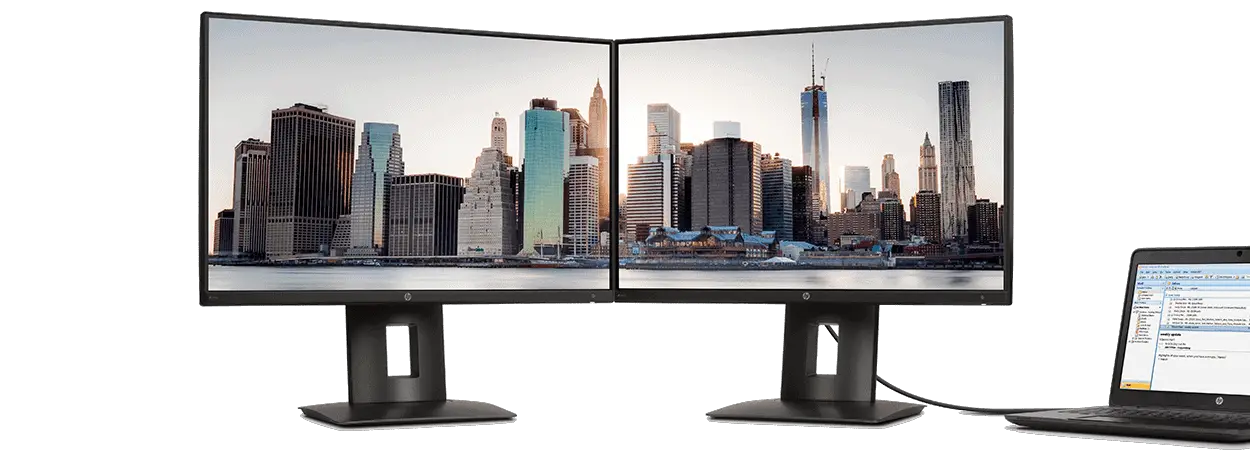Setting up dual monitors on your PC is a great way to get the most out of your computer. Not only can you have multiple windows open at once, but you can also make better use of the increased screen real estate available via two displays. Whether using an older model Windows system or the latest version, setting up dual monitors for your PC is relatively straightforward.
Learn How to Change Mouse Direction on Dual Monitors in our article.

How do you set up dual monitors on a PC?
- Decide which video ports you need for your monitors. If you want to use two different types of monitors (e.g., one VGA and one HDMI), ensure your PC has the correct ports on the graphics card and motherboard.
- If your PC only has one port, you may need to purchase and install a compatible graphics card with multiple ports.
- Ensure the screens have power and appropriate video cables for connecting to your PC’s video port. Then, install any necessary drivers to connect the second monitor—either check online for downloads or install any that came with your display device(s).
- Right-click on an empty spot on the desktop, select ‘Screen Resolution’ from the context menu, and verify that Windows detects both displays in this window.
- You can adjust how the dual monitors are arranged from this window. By default, they are set up side-by-side (either horizontally or vertically, depending on the resolution). However, if desired, you can change it so one monitor is above or below the other in a “stacked” layout.
- Custo “ize how each display functions: Choose whether it should be mirrored (the same content shows up on both displays) or extended (different content shows up on each monitor). Using options like ‘snap,’ ‘cascade,’ and’ an’ ‘ore, you can also adjust how windows are spread across multiple displays — experiment with these settings until they suit your needs!
- To ensure everything is working correctly, go back into ‘Screen Resolution’ and check that’ all settings look correct—if not, reset them as needed before closing this window.
Please watch an excellent video from YouTube to learn how to set up Dual Monitors:
Before we begin, it’s essential to determine whether your system and graphics card can support a dual monitor setup. Typically, modern systems with a discrete graphics card should be able to handle it just fine, but you should still check the documentation provided by your manufacturer to be sure. Sometimes, even if your system has a discrete GPU, it may only support one external display connection, making a dual monitor setup impossible.
Once you’ve establisyou’veat your system is ready for a dual-monitor setup, the next step is connecting them physically to your PC. This part is pretty straightforward: plug each monitor into an appropriate port on the back of your computer (HDMI/DVI/VGA, depending on what type of connections your monitors support). It’s also important to note that typically, one port will be designated as “primary” while “the other “r will be designated as “secondary.” The “s effects “of the two displays interact regarding settings and resolutions, so keep this in mind when connecting them.
Now that both monitors are connected physically to the back of our system and powered up let’s move on to setting settings within Windows. To do this, we’ll need to use Display Settings (which can usually be found by right-clicking anywhere on the desktop and selecting “Display Settings.” From here, “we can choose which display we’d like to our primary display (which will dictate where specific windows and menus show up), adjust resolution settings for each display, or even rotate them if necessary (such as in the case of portrait mode). We can also choose whether or not we’d like our twe’dar displayed on both screens or just one if desired.
Finally, after making any necessary changes or adjustments within Display Settings, we can exit and enjoy our newly configured dual-monitor setup! Now we’ve got plenty of extra space to multitask more effectively than ever before – no more flipping back and forth between windows trying to find what we were looking for! With two physical displays connected and configured correctly, our productivity levels should soar – enjoy!
- Facebook Ads to Get Followers! - December 27, 2024
- ClickUp vs. Slack - December 20, 2024
- Mastering E-Commerce Analytics: A Blueprint for Success





